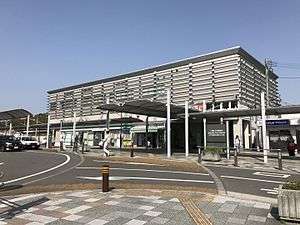Shin-Iizuka Station
Shin-Iizuka Station (新飯塚駅, Shin-Iizuka-eki) is a railway station on the Chikuhō Main Line and Gotōji Line in Iizuka, Fukuoka, Japan, operated by Kyushu Railway Company (JR Kyushu).
Shin-Iizuka Station 新飯塚駅 | |
|---|---|
 Shin-Iizuka Station in April 2017 | |
| Location | Japan |
| Coordinates | 33°38′39″N 130°41′39″E |
| Operated by | |
| Line(s) | ■ Gotōji Line ■ Chikuhō Main Line |
| Other information | |
| Website | Official website |
| Traffic | |
| Passengers (FY2016) | 4,434 daily |
| Rank | 47th |
| Location | |
 Shin-Iizuka Station Location within Japan | |
Lines
Shin-Iizuka Station is served by the Chikuhō Main Line as well as the Gotōji Line, of which it is the western terminus.
History
The privately run Chikuho Kogyo Railway had opened a track from Wakamatsu to Nōgata on 30 August 1891 and after several phases of expansion, the track had reached Iizuka by 1893. On 1 October 1897, the Chikuho Kogyo Railway, now renamed the Chikuho Railway, merged with the Kyushu Railway which undertook further expansion so that the track had reached Nagao (now Keisen by 1901. On 15 June 1902, Shin-Iizuka was opened with the name Yoshiwa as an additional station on the track for freight only. After the Kyushu Railway was nationalized on 1 July 1907, Japanese Government Railways (JGR) took over control of the station. On 12 October 1909, the station became part of the Chikuho Main Line. On 10 May 1920, JGR upgraded Yoshiwa to a general station for both freight and passenger traffic. On 1 February 1935, the name of the station was changed to Shin-Iizuka. With the privatization of Japanese National Railways (JNR), the successor of JGR, on 1 April 1987, control of the station passed to JR Kyushu.[1][2]
Passenger statistics
In fiscal 2016, the station was used by an average of 4,434 passengers daily (boarding passengers only), and it ranked 47th among the busiest stations of JR Kyushu.[3]
See also
References
- Ishino, Tetsu; et al., eds. (1998). 停車場変遷大事典 国鉄・JR編 [Station Transition Directory - JNR/JR] (in Japanese). I. Tokyo: JTB Corporation. pp. 233–4. ISBN 4533029809.
- Ishino, Tetsu; et al., eds. (1998). 停車場変遷大事典 国鉄・JR編 [Station Transition Directory - JNR/JR] (in Japanese). II. Tokyo: JTB Corporation. p. 787. ISBN 4533029809.
- "駅別乗車人員上位300駅(平成28年度)" [Passengers embarking by station - Top 300 stations (Fiscal 2016)] (PDF). JR Kyushu. 31 July 2017. Archived from the original (PDF) on 1 August 2017. Retrieved 25 February 2018.
| Wikimedia Commons has media related to Shin-Iizuka Station. |